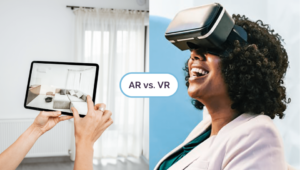In the age of digital innovation, Virtual Reality (VR) and Augmented Reality (AR) have emerged as transformative technologies that have the potential to reshape the way we interact with the digital world and, consequently, our daily lives.
These immersive technologies have opened up new frontiers for entertainment, education, healthcare, and more.
In this article, we will delve into the fascinating world of VR and AR, exploring their origins, applications, and the impact they are having on our world.
Virtual reality (VR), Augmented reality (AR)

Virtual Reality:
VR immerses users in entirely computer-generated environments, shutting out the physical world. To achieve this, users wear specialized headsets that track their head movements and display corresponding images on screens right in front of their eyes.
This creates a 360-degree, immersive experience that can range from playing video games in fictional landscapes to visiting virtual museums or conducting complex surgical training.
Augmented Reality:
AR, on the other hand, enhances our real-world environment by overlaying digital information on it. This is commonly done using smartphone apps or wearable devices like smart glasses.
AR can provide real-time data, such as directions, information about landmarks, or even virtual objects integrated into your surroundings, making it a valuable tool for navigation, education, and entertainment.
Applications of Virtual and Augmented Reality
Virtual and Augmented Reality are no longer confined to the realm of science fiction. They are now making significant impacts in various industries.
Gaming and Entertainment:
Virtual Reality has revolutionized the gaming industry, offering gamers a level of immersion previously unthinkable. VR headsets like Oculus Rift and PlayStation VR transport players to virtual worlds where they can interact with their environment and other players.
Augmented Reality has also made strides in the entertainment industry, with apps like Pokémon GO, which superimposes Pokémon characters onto the real world, creating a global phenomenon.
Education and Training:
VR and AR are becoming invaluable tools for education and training. Medical students can practice surgeries in virtual operating rooms, and astronauts can prepare for space missions through VR simulations.
AR can provide interactive educational content, enhancing learning experiences for students of all ages.
Healthcare:
VR has shown promise in pain management, exposure therapy, and physical rehabilitation. Patients can use VR to distract themselves from pain or engage in therapeutic exercises.
AR, on the other hand, assists surgeons during complex procedures by overlaying crucial patient data onto their field of view.
Architecture and Design:
Architects and designers use VR to create 3D walkthroughs of their projects, allowing clients to experience the designs before they are built.
AR aids in visualizing how furniture or decor items might look in your living space by superimposing virtual objects into your home through a smartphone app.
Manufacturing and Maintenance:
In industrial settings, AR is used to guide workers through complex assembly tasks. Technicians can access real-time information about machinery and perform maintenance more efficiently.
The Impact and Future of VR and AR
As VR and AR continue to mature, they are poised to have a profound impact on society. We can anticipate several key trends:
1. Increased Adoption:
With the proliferation of affordable VR headsets and AR-equipped devices, these technologies will become more accessible to the general population. This will lead to broader adoption in various industries and everyday life.
2. Enhanced Interactivity:
Future developments in VR and AR will focus on improving interactivity and realism. More advanced haptic feedback, realistic graphics, and gesture recognition will create even more immersive experiences.
3. Social and Collaborative VR:
VR platforms like Oculus Horizon are enabling social interactions within virtual worlds, bringing people together from around the globe. Collaborative workspaces in VR will become more prevalent, changing the way we work and communicate.
4. Medical and Therapeutic Advancements:
VR will continue to be explored for its therapeutic applications in areas like mental health, pain management, and physical rehabilitation. Research will uncover new ways in which VR can benefit patients.
5. AR Wearables:
As AR glasses and smart contact lenses become more advanced and accessible, they will blend seamlessly into our daily lives, offering a constant stream of information and assistance.
Virtual Reality (VR) and Augmented Reality (AR) are no longer science fiction; they are reshaping our world. They transcend entertainment, education, healthcare, and industry, offering novel human experiences.
The future of VR and AR knows no bounds, promising limitless potential. With technology’s relentless advance, our reality will perpetually evolve and expand, enriched by these immersive innovations.




